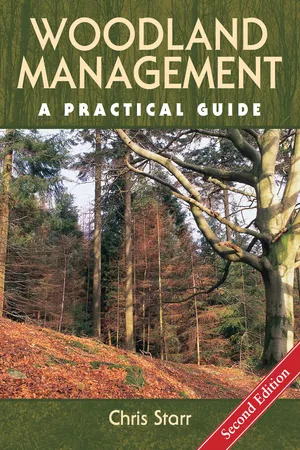
- 192 pages
- English
- ePUB (mobile friendly)
- Available on iOS & Android
About this book
Now in full colour, this is the second edition of this highly acclaimed book. Woodland Management is essential reading for anyone with an interest in trees and woodlands, whether they simply enjoy walking in the woods, are considering buying woodland, or wish to gain a greater understanding of the history and management of Britain's woodland. The book begins with a look at how our woodlands have developed and a discussion of the different types of woodland, and then explores, in a non-technical way, all aspects of management. It considers: broadleaf and conifer woodlands; factors influencing the choice of tree species; surveying and mapping; the seasonal cycle and the operations that occur at different times of the year; conservation and biodiversity; planting new woodland; natural regeneration; coppicing; the types of site; ground preparation; protecting ancient trees; growing trees for timber; thinning and felling; methods of selling timber; generating revenue from timber production and other sources; the factors involved in buying and owning woodlands; where to find grants; how to write a management plan; who to contact for further information; and much more. An indispensable guide for all those interested in maintaining our rich woodland heritage. Now in full colour, this is the second edition of this highly acclaimed book, which is illustrated with 86 colour photographs and 37 diagrams.
Frequently asked questions
- Essential is ideal for learners and professionals who enjoy exploring a wide range of subjects. Access the Essential Library with 800,000+ trusted titles and best-sellers across business, personal growth, and the humanities. Includes unlimited reading time and Standard Read Aloud voice.
- Complete: Perfect for advanced learners and researchers needing full, unrestricted access. Unlock 1.4M+ books across hundreds of subjects, including academic and specialized titles. The Complete Plan also includes advanced features like Premium Read Aloud and Research Assistant.
Please note we cannot support devices running on iOS 13 and Android 7 or earlier. Learn more about using the app.
Information
CHAPTER 1
Woodlands: Past, Present and Future
The Wildwood
Forest Types

Native Tree Species
Wood Pasture and High Forest
| Table 1: The native tree species of Britain | ||||
| Common name | Botanical name | Notes | ||
| Common juniper | Juniperus communis | Now restricted to small isolated upland and heathland sites | ||
| Downy birch | Betula pubescens | Typical pioneer species, with local adaptations to site | ||
| Silver birch | Betula pendula | Typical pioneer species, with local adaptations to site | ||
| Aspen | Populus tremula | |||
| Scots pine | Pinus sylvestris | Once native in southern England when the climate was cooler than it is today | ||
| Bay willow | Salix pentandra | Native willows important for insects | ||
| Common alder | Alnus glutinosa | |||
| Hazel | Corylus avellana | |||
| Small-leaved lime | Tilia cordata | |||
| Bird cherry | Prunus padus | |||
| Goat willow | Salix caprea | |||
| Wych elm | Ulmus glabra | |||
| Rowan | Sorbus aucuparia | |||
| Sessile oak | Quercus petraea | Important for insects and lichens | ||
| Ash | Fraxinus excelsior | |||
| Holly | Ilex aquifolium | |||
| English oak | Quercus robur | |||
| Hawthorn | Crataegus monogyna | |||
| Crack willow | Salix fragilis | |||
| Black poplar | Populus nigra var. betulifolia | Quite rare. Not to be confused with the introduced hybrid black poplars | ||
| Yew | Taxus baccata | Poor for wildlife but of high cultural value | ||
| Whitebeam | Sorbus aria | |||
| Midland thorn | Crataegus laevigata | |||
| Crab apple | Malus sylvestris | |||
| Wild cherry (Gean) | Prunus avium | |||
| Strawberry tree | Arbutus unedo | |||
| White willow | Salix alba | |||
| Field maple | Acer campestre | |||
| Wild service tree | Sorbus torminalis | |||
| Large-leaved lime | Tilia platyphyllos | |||
| Beech | Fagus sylvatica | |||
| Hornbeam | Carpinus betulus | |||
| Box | Buxus sempervirens | Restricted to southern England, this was the last tree to cross from Europe before the English Channel formed | ||
The Changing Face of Woodland
Table of contents
- Cover
- Title Page
- Copyright
- Contents
- Acknowledgements
- Introduction
- Chapter 1 Woodlands: Past, Present and Future
- Chapter 2 Getting to Know Trees and Woodlands
- Chapter 3 The Broadleaves
- Chapter 4 The Conifers
- Chapter 5 A Vision for the Woodland
- Chapter 6 Getting to Know Your Woodland
- Chapter 7 Biodiversity Matters
- Chapter 8 Regenerating and Creating Woodland
- Chapter 9 The Seasonal Cycle and Woodland Maintenance
- Chapter 10 Silviculture and Stewardship
- Chapter 11 Generating an Income from Woodland
- Chapter 12 Buying and Owning a Woodland
- Glossary
- Further Reading
- Useful Addresses
- Index
- Metric/Imperial Conversion Factors